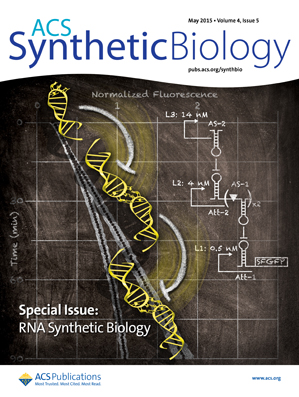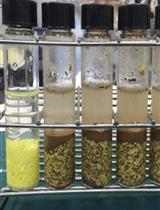- EN - English
- CN - 中文
Transfer of Large Contiguous DNA Fragments onto a Low Copy Plasmid or into the Bacterial Chromosome
将大片段DNA克隆到低拷贝质粒或细菌染色体
发布: 2016年11月20日第6卷第22期 DOI: 10.21769/BioProtoc.2002 浏览次数: 11836
评审: Lionel SchiavolinKanika GeraAnonymous reviewer(s)
Abstract
Bacterial pathogenicity islands and other contiguous operons can be difficult to clone using conventional methods due to their large size. Here we describe a robust 3-step method to transfer large defined fragments of DNA from virulence plasmids or cosmids onto smaller autonomously replicating plasmids or directly into defined sites in the bacterial chromosome that incorporates endogenous yeast and λ Red homologous recombination systems. This methodology has been successfully used to isolate and integrate at least 31 kb of contiguous DNA and can be readily adapted for the recombineering of E. coli and its close relatives.
Background
The ability to isolate and propagate large pieces of DNA has vastly expanded the study of gene networks and operons. However, the traditionally used engineered plasmids for this purpose, such as bacterial artificial chromosomes (BACs), while extremely useful, are limited by problems with DNA stability, copy number, and complex assembly requirements. Alternatively, incorporating constructs directly into the bacterial chromosome provides advantages by both reducing variations in gene expression arising from the presence of multiple gene copies and ensuring stable maintenance of genes, while also avoiding the need for antibiotic selection.
The methodologies described here were originally designed to capture and transfer the 31 kb of DNA operons that encode the Shigella flexneri type 3 secretion system onto the Escherichia coli chromosome (Reeves et al., 2015). The procedure utilizes yeast homologous recombination to generate a capture vector, a plasmid that contains regions of DNA that flank the fragment to be transferred, followed by using the λ Red recombination system to transfer the region of DNA of interest from a large virulence plasmid or cosmid onto the capture vector. The introduction of unique ‘Landing Pad’ sequences flanking the target sequence can be used to transfer via site-specific recombination the region of DNA present on the capture vector to an experimentally defined location on the bacterial chromosome using a protocol previously established by Kuhlman and Cox (2010). The inclusion of flanking landing pad sequences does not preclude the propagation of the DNA of interest on an autonomously replicating plasmid, but rather affords the opportunity to subsequently introduce the captured DNA onto a defined site on the bacterial chromosome. While we favor the use of an engineered landing pad sequence, one could adapt the approach described below to target the insertion of the captured DNA to a specifically defined locus on the bacterial chromosome.
Materials and Reagents
- 1.7 ml microcentrifuge tubes
- Acid-washed, small glass beads, 425-600 μm (30-40 U.S. sieve) (Sigma-Aldrich, catalog number: G8772 )
- Large glass beads, 5 mm (Corning, catalog number: 7268-5 )
- Cell scrapers (Corning, Falcon®, catalog number: 353085 )
- Electroporation cuvettes (Thermo Fisher Scientific, Fisher Scientific, catalog number: FB101 )
- Petri dishes (100 x 15 mm) (VWR, catalog number: 89038-968 )
- ElectroMAXTM DH10β cells (Thermo Fisher Scientific, InvitrogenTM, catalog number: 18290015 )
- Saccharomyces cerevisiae yeast strain (BY4741) (GE Healthcare Dharmacon, catalog number: YS1048 or other ura3 minus strain)
- E. coli DH10β atp/gidB::Landing pad cassette. Tetracycline resistant strain harboring an integrated landing pad cassette (for use if transferring captured DNA into the chromosome) (Addgene, catalog number: 83036 )
- pLLX13 plasmid, or another suitable yeast/bacteria shuttle vector (Addgene, catalog number: 79825 )
- pLLX8 plasmid, or another suitable vector that encodes the desired antibiotic resistance cassette (Addgene, catalog number: 79838 )
- pKD46, temperature sensitive, λ red recombinase expression plasmid, or similar (Datsenko and Wanner, 2000)
- pTKred plasmid, temperature sensitive, bacterial expression vector for λ Red recombinase and I-SceI (Addgene, catalog number: 41062 )
- Gene specific primers (see Table 1)
- Yeast nitrogen base with ammonium sulfate (MP Biomedicals, catalog number: 114027-532 )
- CSM-URA, uracil dropout supplement (MP Biomedicals, catalog number: 4511-222 )
- D-glucose (Thermo Fisher Scientific, Fisher Scientific, catalog number: D16-10 )
- Agar (Thermo Fisher Scientific, Fisher Scientific, catalog number: BP1423-2 )
- L-(+)-arabinose (Sigma-Aldrich, catalog number: A3256-100 )
- Ampicillin sodium salt (Sigma-Aldrich, catalog number: A9518-25G )
- Kanamycin monosulfate (MP Biomedicals, catalog number: 02150029 )
- Tetracycline hydrochloride (Sigma-Aldrich, catalog number: T7660 )
- Spectinomycin dihydrochloride pentahydrate (Sigma-Aldrich, catalog number: S9007-5G )
- Distilled, deionized water
- Magnesium sulfate (MgSO4) (Sigma-Aldrich, catalog number: M2643-500G )
- KOD hot start DNA polymerase (EMD Millipore, catalog number: 71-086-3 )
- QIAquick Gel Extraction Kit (QIAGEN, catalog number: 28704 )
- NheI-HF® restriction enzyme (New England Biolabs, catalog number: R3131S )
- PmeI restriction enzyme (New England Biolabs, catalog number: R0560S )
- MluI-HF® restriction enzyme (New England Biolabs, catalog number: R3198S )
- Yeast extract (Thermo Fisher Scientific, Fisher Scientific, catalog number: BP1422-2 )
- Peptone (Thermo Fisher Scientific, Fisher Scientific, catalog number: BP1420-2 )
- Glycerol (Thermo Fisher Scientific, Fisher Scientific, catalog number: BP229-4 )
- Polyethylene glycol 3350 (PEG 3350) (Sigma-Aldrich, catalog number: 202444 )
- Lithium acetate (LiOAc) (Sigma-Aldrich, catalog number: 517992 )
- DNA sodium salt from salmon testes (Sigma-Aldrich, catalog number: D1626 ), resuspended in TE buffer (2 mg/ml)
- Tris-HCl, pH 8.0 (Promega, catalog number: H5123 )
- EDTA (Sigma-Aldrich, catalog number: E5134-500G )
- QIAprep Spin Miniprep Kit (QIAGEN, catalog number: 27104 )
- Sodium chloride (NaCl) (Sigma-Aldrich, catalog number: S3014-500G )
- Potassium chloride (KCl) (Sigma-Aldrich, catalog number: P5405-250G )
- Sodium acetate (NaOAc) (Sigma-Aldrich, catalog number: S2889 )
- Selective antibiotics
Kanamycin monosulfate (1,000x stock) (see Recipes)
Ampicillin sodium salt (1,000x stock) (see Recipes)
Tetracycline hydrochloride (1,000x stock) (see Recipes)
Spectinomycin dihydrochloride pentahydrate (1,000x stock) (see Recipes) - CSM-Ura selective media (see Recipes)
- YEPD media (see Recipes)
- TE buffer (see Recipes)
- SOB broth (see Recipes)
- SOC broth (see Recipes)
Equipment
- 100-150 ml Erlenmeyer flask
- Vortex (Scientific Industries, catalog number: SI-0136 )
- Incubators, set to 37 °C and 30 °C
- Water baths or heat blocks, set to 42 °C, 37 °C and 30 °C
- Microcentrifuge (Eppendorf, model: 5424 )
- Large centrifuge, able to handle up to 50 ml (for making competent yeast and bacteria)
- Electrophoresis system
- UV transilluminator
- Thermocycler (Bio-Rad Laboratories, model: PTC 200 ) or any other conventional thermocycler
- GenePulser II electroporation system (Bio-Rad Laboratories) or other electroporation device
- Nanodrop Lite spectrophotometer (Thermo Fisher Scientific, model: NanoDrop Lite ), or any other equipment/method suitable for quantifying DNA concentration
- Roller drum or shaker
Procedure
文章信息
版权信息
© 2016 The Authors; exclusive licensee Bio-protocol LLC.
如何引用
Reeves, A. Z. and Lesser, C. F. (2016). Transfer of Large Contiguous DNA Fragments onto a Low Copy Plasmid or into the Bacterial Chromosome. Bio-protocol 6(22): e2002. DOI: 10.21769/BioProtoc.2002.
分类
微生物学 > 微生物遗传学 > 基因图谱和克隆
您对这篇实验方法有问题吗?
在此处发布您的问题,我们将邀请本文作者来回答。同时,我们会将您的问题发布到Bio-protocol Exchange,以便寻求社区成员的帮助。
Share
Bluesky
X
Copy link












